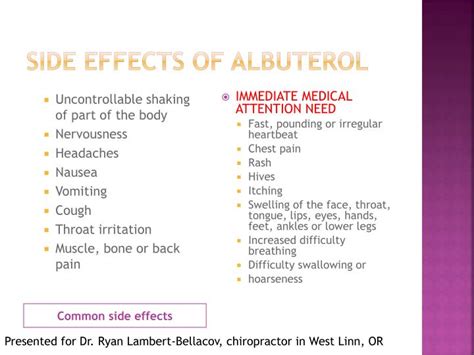Intro
Albuterol, a medication commonly used to treat respiratory conditions such as asthma and chronic obstructive pulmonary disease (COPD), is often administered via a nebulizer. A nebulizer is a device that converts liquid medication into a fine mist, making it easier to inhale into the lungs. Understanding the proper dosage of albuterol when using a nebulizer is crucial for effective treatment and minimizing potential side effects.

What is Albuterol and How Does it Work?
Albuterol is a bronchodilator, a type of medication that helps relax the muscles in the airways, making it easier to breathe. When inhaled, albuterol works by stimulating the beta-2 receptors in the lungs, which causes the airway muscles to relax and dilate. This allows for improved airflow and reduced symptoms of respiratory conditions such as wheezing, coughing, and shortness of breath.
Benefits of Using a Nebulizer for Albuterol Administration
Using a nebulizer to administer albuterol has several benefits. Nebulizers are particularly useful for patients who have difficulty using inhalers, such as young children, elderly individuals, or those with severe respiratory conditions. Nebulizers also allow for a more targeted delivery of medication directly to the lungs, which can be more effective than inhalers in some cases.
Albuterol Nebulizer Dose: Standard Recommendations
The standard recommended dose of albuterol for nebulizer administration varies depending on the specific condition being treated and the individual patient's needs. For most adults and children over 12 years old, the typical dose is 2.5-5mg per treatment, given every 4-6 hours as needed. For children between 6-12 years old, the typical dose is 1.25-2.5mg per treatment.

Factors Affecting Albuterol Nebulizer Dose
Several factors can affect the recommended dose of albuterol for nebulizer administration. These include:
- Severity of symptoms: Patients with more severe symptoms may require higher doses or more frequent treatments.
- Age and weight: Children and elderly individuals may require lower doses due to their smaller size and potential sensitivity to the medication.
- Other medical conditions: Patients with certain medical conditions, such as heart disease or high blood pressure, may require adjusted doses or closer monitoring.
- Response to treatment: Patients who do not respond to the standard dose may require higher doses or alternative treatments.
Potential Side Effects and Risks
While albuterol is generally a safe and effective medication, there are potential side effects and risks to be aware of. Common side effects include:
- Tremors or shakiness
- Nervousness or anxiety
- Headache
- Dizziness or lightheadedness
- Rapid heartbeat or palpitations
More serious side effects can occur, such as:
- Increased heart rate or blood pressure
- Electrolyte imbalance
- Allergic reactions

Minimizing Risks and Side Effects
To minimize the risks and side effects associated with albuterol nebulizer treatment, it is essential to:
- Follow the recommended dose and treatment schedule
- Monitor blood pressure and heart rate regularly
- Report any side effects or concerns to a healthcare provider
- Use a spacer or valve with the nebulizer to reduce medication waste and improve delivery
Conclusion: Effective Albuterol Nebulizer Treatment
In conclusion, understanding the proper dosage of albuterol for nebulizer administration is crucial for effective treatment of respiratory conditions. By following standard recommendations and adjusting the dose based on individual needs, patients can minimize potential side effects and risks. Regular monitoring and communication with a healthcare provider are essential for optimal treatment outcomes.
What is the standard recommended dose of albuterol for nebulizer administration?
+The standard recommended dose of albuterol for nebulizer administration varies depending on the specific condition being treated and the individual patient's needs. For most adults and children over 12 years old, the typical dose is 2.5-5mg per treatment, given every 4-6 hours as needed.
What are the potential side effects of albuterol nebulizer treatment?
+
How can I minimize the risks and side effects associated with albuterol nebulizer treatment?
+To minimize the risks and side effects associated with albuterol nebulizer treatment, it is essential to follow the recommended dose and treatment schedule, monitor blood pressure and heart rate regularly, report any side effects or concerns to a healthcare provider, and use a spacer or valve with the nebulizer to reduce medication waste and improve delivery.
